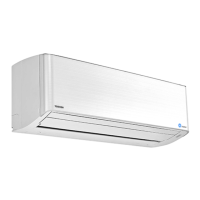Do you have a question about the Toshiba RAS-M13YKCV-E and is the answer not in the manual?
Details operational parameters for various indoor/outdoor unit combinations.
Performance data based on indoor/outdoor unit combinations and conditions.
Technical specifications for electrical components and system limits.
Crucial safety precautions for handling R410A refrigerant during installation and servicing.
Guidelines for proper installation of refrigerant piping materials and joints.
Lists required and recommended tools for R410A system installation and servicing.
Step-by-step procedure for safely recharging refrigerant into the system.
Details on materials and techniques for brazing refrigerant pipes to ensure integrity.
Exploded view and dimensions of the indoor unit components.
Exploded view and dimensions of the outdoor unit components.
Schematic illustrating electrical connections for the indoor unit.
Schematic illustrating electrical connections for the outdoor unit.
List of electrical components and their specifications for the indoor unit.
List of electrical components and their specifications for the outdoor unit.
Performance data (pressure, temperature, fan speed) under various operating conditions.
Block diagram showing the control logic and components of the indoor unit.
Block diagram illustrating the control logic and components of the outdoor unit.
Overview of how the indoor and outdoor units communicate and control operations.
Explanation of how compressor speed adjusts cooling/heating capacity.
Explains the operational logic for various modes like Cooling, DRY, and Heating.
Detailed description of the cooling mode operation and controls.
Detailed description of the DRY mode operation, focusing on dehumidification.
Detailed description of the heating mode operation and defrost control.
Explains the auto restart feature and how to set/cancel it.
Details the parts and indications on the remote controller.
Critical safety warnings and precautions for installing the air conditioner.
Step-by-step guide for installing the indoor unit.
Guidelines and precautions for installing the outdoor unit.
Initial checks for power supply and voltage before diagnosing issues.
Interpreting indoor unit LED indicators for self-diagnosis codes.
Using the remote controller to perform self-diagnosis and check error codes.
Troubleshooting based on observed symptoms for indoor and outdoor units.
Interpreting outdoor unit LED indicators for fault diagnosis.
Step-by-step diagnosis for outdoor unit and inverter assembly issues.
Procedures for checking key components like P.C. boards and motors.
Method for testing the outdoor fan motor's functionality.
Step-by-step instructions for replacing main parts of the indoor unit.
Step-by-step instructions for replacing main parts of the outdoor unit.
Exploded view and part list for the first indoor unit configuration.
Exploded view and part list for the outdoor unit.
Diagrams showing the layout and part numbers of P.C. boards.
| Brand | Toshiba |
|---|---|
| Model | RAS-M13YKCV-E |
| Category | Air Conditioner |
| Language | English |












